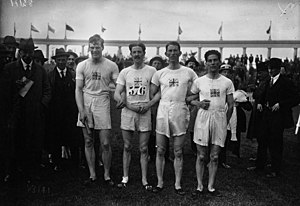 British relay team at the 1920 Olympics, Ainsworth-Davis is 2nd left | ||||||||||||
| Personal information | ||||||||||||
|---|---|---|---|---|---|---|---|---|---|---|---|---|
| Born | 23 April 1895 Aberystwyth, Wales | |||||||||||
| Died | 3 January 1976 (aged 80) Stockland, Devon, England | |||||||||||
| Alma mater | University of Cambridge | |||||||||||
| Sport | ||||||||||||
| Sport | Athletics | |||||||||||
| Event | 400 m | |||||||||||
| Club | University of Cambridge | |||||||||||
| Achievements and titles | ||||||||||||
| Personal best | 400 m – 50.0e (1920)[1][2] | |||||||||||
Medal record
| ||||||||||||
John Creyghton Ainsworth-Davis (23 April 1895 – 3 January 1976) was a Welsh surgeon and sprint runner who won a gold medal in the 4 × 400 m relay at the 1920 Summer Olympics.[3]
Biography
[edit]John Ainsworth-Davis studied at Westminster School. During World War I he first served as a captain with the Rifle Brigade and then as pilot in the Royal Flying Corps.[citation needed]
At the 1920 Summer Olympics Ainsworth-Davis ran the third leg for the British 4 × 400 m relay team, which won the event. He also competed in the individual 400 m, to replace Cecil Griffiths who fell ill, and finished fifth.[1][4]
After graduating from University of Cambridge Ainsworth-Davis studied medicine at St. Bartholomew's Hospital and played music at a nightclub to support his family. He could not make time for sport, and retired from competitions after placing fourth in the 440 yards at the 1921 AAA Championships. He became a respected urological surgeon and the Secretary of the Royal Society of Medicine (RSM). During World War II he was head of the surgical division of RAF Hospital Cosford.[1] Later he served as Secretary and President of the Hunterian Society (1958) and Secretary of the RSM.[citation needed]
Ainsworth-Davis married Marguerite C. Wharry in 1920, with whom he had three children: Mary (1923), John Christopher (1924) (an actor/director/author who wrote under the pen name of Christopher Creighton and used the name John Ainsworth in the theatrical world),[5][6] and Jennifer (1930).
See also
[edit]References
[edit]- ^ a b c John Ainsworth-Davis Archived 12 November 2012 at the Wayback Machine. sports-reference.com
- ^ John Ainsworth-Davis. trackfield.brinkster.net
- ^ "John Ainsworth-Davis". Olympedia. Retrieved 8 July 2021.
- ^ "Going for Gold: 1 Cambridgeshire's Olympians". Cambridgeshire County Council. 21 July 2011. Archived from the original on 27 May 2012. Retrieved 4 July 2012.
- ^ "John Ainsworth – IMDb". IMDb.
- ^ "Books: The spy who went after the gold | The Independent | The Independent". Independent.co.uk.
- ^ "Obituary Notices". British Medical Journal. 1 (6004): 287–289. 31 January 1976. ISSN 0007-1447. PMC 1638570. PMID 764932.
Further reading
[edit]- Buchanan, Ian British Olympians. Guinness Publishing (1991) ISBN 0-85112-952-8